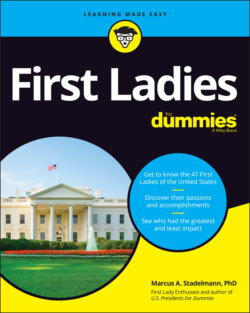Читать книгу First Ladies For Dummies - Marcus A. Stadelmann, Marcus A. Stadelmann PhD - Страница 11
The Changing Role of First Ladies in the United States
ОглавлениеIN THIS CHAPTER
Setting the foundation
Being graceful hostesses
Refusing the job
Starting to matter
Becoming copresidents
The story of the First Ladies of the United States is one of drama, personal struggle, and both great successes and failures. It’s a story of ambition, joy, disappointment, and most often a total loss of privacy. In the early years of the republic, becoming First Lady imposed considerable dangers, both social and economic, on First Ladies and their families. The White House was open to just about everyone, and it had no security yet.
Today, First Ladies have professional roles and often aid in policy development. They work together with Congress and have become active policy makers. However, every First Lady decides how active they’ll be. Hillary Clinton was one of the most active First Ladies in recent history, while Melania Trump was less active and played the role of a more traditional First Lady (see Chapter 20 for more). A First Lady’s temperament, family situation, character, and even relationship with the president determines all of that. First Ladies with big political ambitions can use their office as a stepping stone to future offices. Eleanor Roosevelt did so with working for the United Nations after leaving her role as First Lady in 1945 (see Chapter 14), and Hillary Clinton ran and won a U.S. Senate seat after serving two terms as First Lady (see Chapter 18).
The role of First Lady has seen significant changes over the years. Women have made progress in society and are found at the highest levels of government, including now the vice presidency. Women today serve in Congress, even becoming the Speaker of the House of Representatives; they are members of the Supreme Court; and they govern states. It’s only a question of time before a woman will become president and the U.S. will have its first “First Gentleman.”
